Rada Akbar: Afghan Artist and Photographer

In the contemporary history of Afghanistan, Rada Akbar stands as one of the most prominent artistic, cultural, and social figures who has elevated art beyond aesthetics, transforming it into a tool of resistance, awakening, and representation of women’s identity.
She is an artist who speaks through her lens about the pain, strength, and resilience of Afghan women—those who have lived amid war, discrimination, and silence, yet have preserved their creative spirit.
Rada Akbar is among the few artists who have managed to create a new language of beauty, awareness, and protest from within the ruins and restrictions. Her works are a reflection of the unwritten history of Afghan women—a history inscribed not in books, but in faces, fabrics, and gazes.
Life and Artistic Journey
Born in Kabul, Rada Akbar grew up during years marked by war, displacement, and cultural deprivation. From an early age, she possessed a deep, poetic way of seeing the world. She came of age in an environment where artistic expression, especially for women, was both difficult and dangerous. Yet Rada chose to give voice to the silence of Afghan women through imagery that transcended borders.
Her early works were rooted in documentary and artistic photography, but over time, her vision expanded into conceptual and symbolic creations. In her art, every element—from color and light to costume and gesture—holds meaning. Her works combine social realism, conceptual design, and costume art, creating a unique visual language of identity and resistance.
Central Themes: Woman, Identity, and Resistance
At the heart of Rada Akbar’s art stands the Afghan woman — not as a victim, but as a powerful, aware, and dignified being. Her works redefine Afghan femininity through strength and endurance rather than suffering.
One of her most acclaimed projects, “Superwomen of Afghanistan,” pays tribute to Afghan women who, throughout history, have shaped the country’s destiny in science, art, politics, and activism — women whose names have too often been forgotten in silence.
In this project, Akbar designs costumes inspired by Afghanistan’s historical and cultural heritage, turning each woman into a symbol of a specific era and struggle. She reimagines women not as passive subjects, but as heroic, visionary figures radiating grace and authority.
Art as a Form of Resistance
For Rada Akbar, art is not merely for beauty or entertainment — it is a form of cultural and political resistance. She believes that in times of conflict and extremism, when identity and heritage are under threat, art becomes a shield against erasure and distortion.
As Akbar once said:
“For Afghan women, art is a refuge — a place where we can scream, even if our voices are silenced outside.”
Her works explore concepts such as womanhood, body, power, silence, and freedom, all expressed through symbolic colors and forms. She uses photography as a medium of global dialogue — between East and West, tradition and modernity, silence and voice.
Rada Akbar and the Language of Cinema, Fashion, and Design
What distinguishes Rada Akbar’s work is her fusion of photography with costume and cinematic design. Through dramatic composition, lighting, and historical dress, each image becomes a visual narrative.
Some critics describe her as a “cinematographer of still images.”
In her art, clothing is not merely aesthetic—it is symbolic. Each fabric, color, and ornament conveys a story of culture and history, from Badakhshan’s traditional patterns to motifs inspired by the Timurid era of Herat.
Global Recognition and Exhibitions
Rada Akbar’s works have been exhibited internationally across Europe, the United States, and the Middle East, receiving acclaim from critics and audiences alike. She has participated in exhibitions in Paris, Berlin, Rome, New York, and Doha, earning multiple awards for innovation in contemporary art.
After the Taliban’s return to power in 2021, Akbar was forced into exile. However, she continued her artistic mission abroad, producing new projects that focus on “Women in Exile” and “Cultural Memory of Afghanistan.”
Her work remains a testament to courage and artistic integrity, proving that even displacement cannot silence the creative voice of an artist committed to truth.
Inspiration for a New Generation
For Afghanistan’s younger generation—especially for girls—Rada Akbar is a symbol of courage, creativity, and freedom. Despite political and social pressures, she demonstrated that art can flourish even under constraint.
Her message is both simple and profound:
“No power can silence the imagination of a free woman.”
Through her talks and cultural programs, she continues to inspire youth to pursue education, creation, and self-belief as pathways to transformation.
Legacy and Lasting Influence
In Afghanistan’s cultural history, Akbar occupies a unique place: she is a bridge between past and future, between local art and global expression, and between the silence of yesterday and the voices of today’s women.
Rada Akbar belongs to that rare generation of artists who reshaped the global image of Afghan women. With her courage and creativity, she offered the world a new portrait of Afghan femininity—not defined by pain, but by intellect, strength, and renewal.
Rada Akbar is an artist who does not merely narrate history—she recreates it through vision and imagination. Her works remind us that Afghan women have not only endured fate but have reshaped it through art and resilience.
Her name, alongside those of Goharshad Begum and Mehpari Tahira, will remain a symbol of culture, bravery, and creation—a light shining through the dark chapters of Afghanistan’s story.